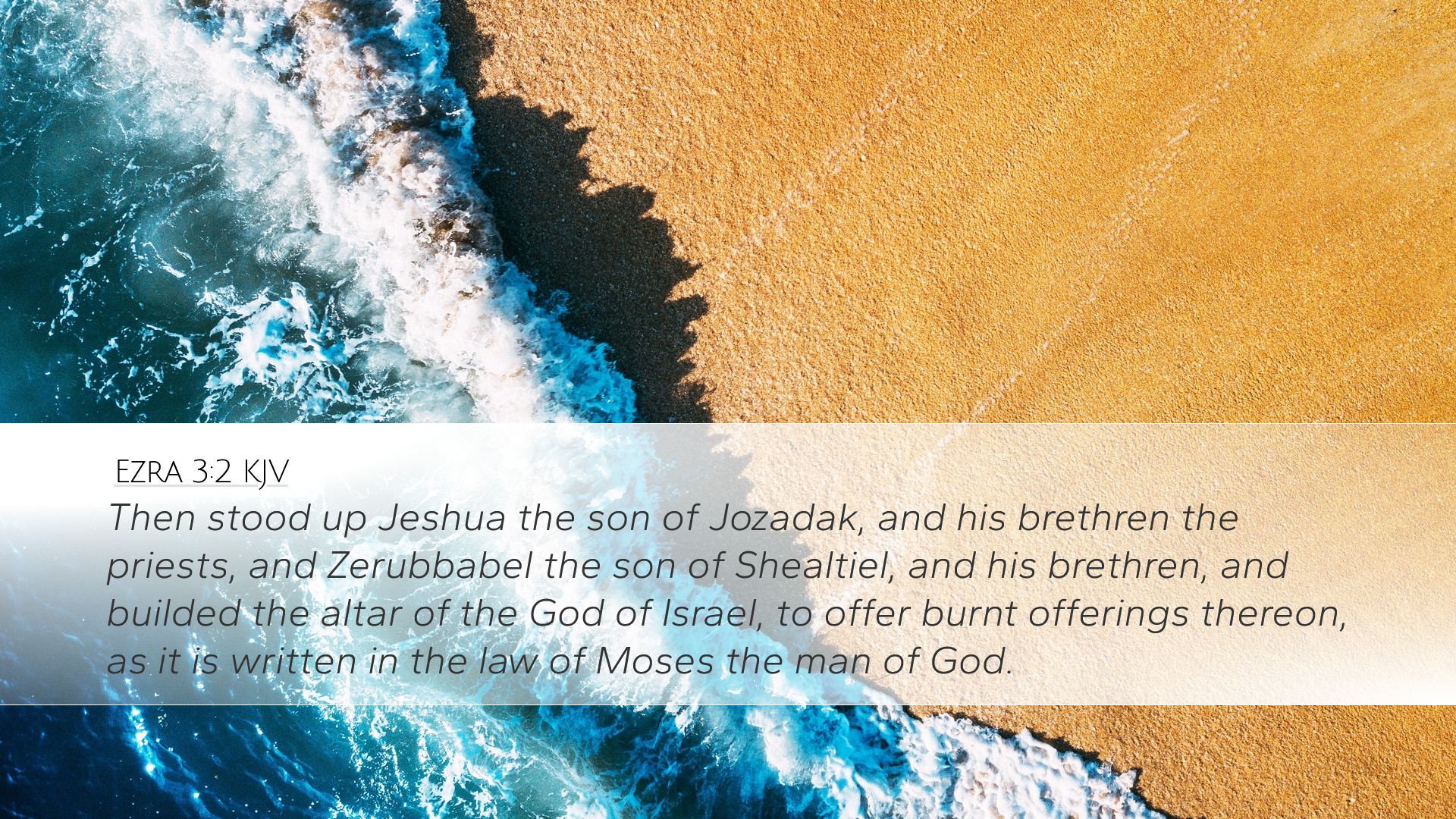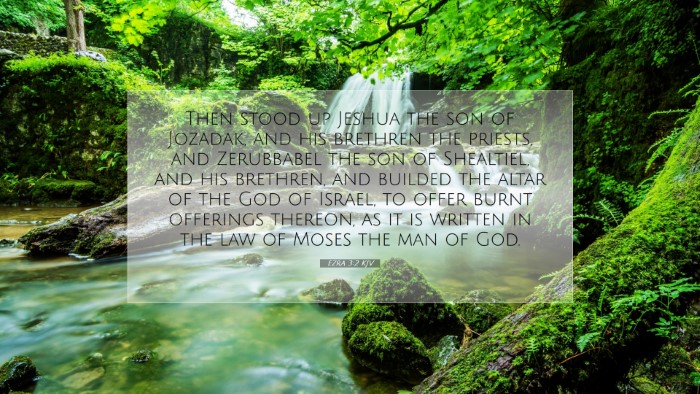Old Testament
Genesis Exodus Leviticus Numbers Deuteronomy Joshua Judges Ruth 1 Samuel 2 Samuel 1 Kings 2 Kings 1 Chronicles 2 Chronicles Ezra Nehemiah Esther Job Psalms Proverbs Ecclesiastes Song of Solomon Isaiah Jeremiah Lamentations Ezekiel Daniel Hosea Joel Amos Obadiah Jonah Micah Nahum Habakkuk Zephaniah Haggai Zechariah MalachiEzra 3:2
Ezra 3:2 KJV
Then stood up Jeshua the son of Jozadak, and his brethren the priests, and Zerubbabel the son of Shealtiel, and his brethren, and builded the altar of the God of Israel, to offer burnt offerings thereon, as it is written in the law of Moses the man of God.
Ezra 3:2 Bible Commentary
Commentary on Ezra 3:2
Ezra 3:2 states: "Then stood up Jeshua the son of Jozadak, and his brethren the priests, and Zerubbabel the son of Shealtiel, and his brethren, and built the altar of the God of Israel, to offer burnt offerings thereon, as it is written in the law of Moses the man of God."
Contexts and Background
This verse marks a significant moment in the history of Israel after the Babylonian exile. The rebuilding of the altar signifies the restoration of worship following years of captivity. The returnees, led by Jeshua and Zerubbabel, demonstrate their commitment to God's covenant by seeking to reestablish proper worship protocols.
Leadership and Initiatives
The characters in this verse hold substantial roles: Jeshua, a priest, and Zerubbabel, the governor, represent both spiritual and political leadership. This dual leadership is crucial for the community's restoration. As Albert Barnes notes, the involvement of priests signifies the importance of the temple service and the proper exercise of religious duties.
Jeshua the Priest
Jeshua, being a direct descendant of Aaron, represents the continuity of the priestly line. His role in rebuilding the altar indicates a return to the sacrificial system that was central to Israelite worship. Matthew Henry emphasizes the importance of Jeshua’s leadership in restoring the spiritual life of the community, highlighting that true worship starts from properly appointed leaders.
Zerubbabel the Governor
Zerubbabel, the grandson of Jehoiachin, symbolizes the political restoration of Israel’s leadership. Adam Clarke points out that his involvement signifies a re-establishment of civil authority in conjunction with spiritual recovery. This duality underscores the significance of both realms working together towards the rebuilding of the community.
Restoration of Worship
The act of building the altar was fundamental. It wasn't simply a structure; it was a reflection of their renewed covenant with God. They were committing themselves to the laws that Moses provided, which emphasized worship and the need for sacrificial offerings. This return to worship is a critical theme that resonates throughout the biblical narrative.
Significance of the Altar
- Point of Atonement: The altar served as the place for burnt offerings, essential for atonement and an expression of devotion to God.
- Restoration of Relationship: By building the altar, the people signified their desire to restore their relationship with God that had been strained during the exile.
- Community and Worship: The communal act of building represents unity among the returnees. It was a shared commitment to worshiping God.
Fulfillment of Prophecy
The return and rebuilding were in fulfillment of the prophecies given through Jeremiah and others, which declared the restoration of Israel after their period of exile. Matthew Henry notes that such prophetic assurances provided hope and purpose for the people as they sought to return to their homeland.
Lessons for Contemporary Believers
This verse and its context provide significant insights for modern believers and church leaders:
- Leadership Matters: The importance of godly leadership in spiritual and practical matters cannot be overemphasized. Leaders must guide their communities back to God.
- Prioritizing Worship: Just as the returnees prioritized building an altar, contemporary believers should prioritize worship and seek genuine expressions of faith in church and community life.
- Unity in Purpose: There is a call for unity among believers. Engaging in a shared purpose helps strengthen communities and points them to God’s mission.
- Faithful Remembrance: The act of remembering God’s past faithfulness encourages present and future obedience. The people referred back to the law of Moses, which provided structure and guidance for their worship.
Conclusion
Ezra 3:2 serves as a powerful reminder of the importance of establishing a proper foundation for worship. The collaboration between spiritual and civic leaders is essential for community restoration. As believers today reflect on this passage, they are called to consider their own commitments to worship, leadership, and community in the light of God’s redeeming work.


